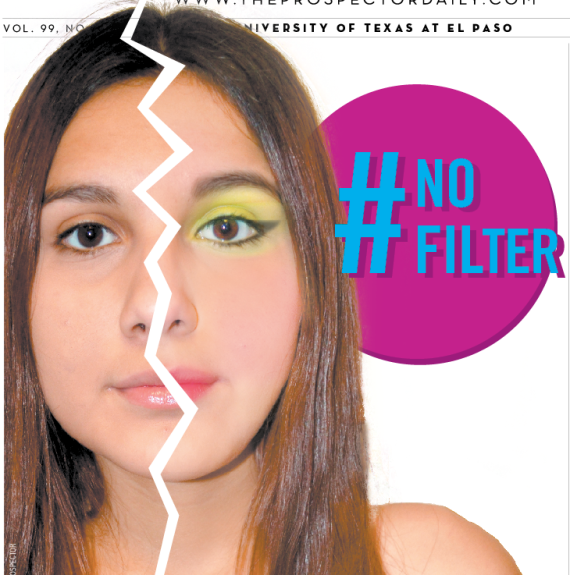An “ideal beauty” lives on magazine racks and television screens at all hours of the day. She is thin and built with clear skin, free of wrinkles or scars. She has perfect hair, big lips, a long neck and eyelashes. She has the right-sized bust, with a flat stomach, thin arms and long legs—but she isn’t real.
Technology allows us to completely distort images to correct flaws in skin, color, size and weight, which many have said has lead to a false societal idea of beauty. But some think this retouched beauty may change as media images head into a more natural direction.
Ruth McDonald, lecturer in the Women Studies Program, teaches Introduction to Women’s Studies and Gender and Pop Culture courses. McDonald said the view of women from media such as advertising, television and movies has a pronounced presence in today’s culture: a flawless image in media.
“There’s some change, but there is still a dominant paradigm of expectations of females who are in professions of acting, modeling or fashion,” McDonald said. “We are seeing some changes—there has been some push back by society.”
McDonald also said there is more awareness to the false perfection seen in magazines, where photos have been retouched, but she said she would not call going natural a major trend in advertising.
“Major stories in media are when an actress has a baby,” she said. “The headlines focus on how fast she can slim down again.”
American Apparel is breaking the perfection mold. The 16-year-old clothing company has been involved in changing the norms. In 2012, Jackie O’Shaughnessy, then 60-years-old, appeared in an ad on Facebook wearing nothing but her skivvies. The ad read, “Sexy Has No Expiration Date.”
American Apparel also recently set up a display case in New York, featuring mannequins with pubic hair modeling lingerie. District Visual Manager Dee Myles said in an interview with the New York Observer, “It’s important to have instances spark up curiosity and conversation about what we deem beautiful and sexy.”
Some in Hollywood are also pushing for a more natural approach to beauty such as Shailene Woodley, a 23-year-old actress appearing in a number of roles including “The Secret Life of an American Teenager” and “The District.” She refuses to wear makeup on the red carpet.
In an interview with Flavorwire, Woodley said she saw herself in a magazine once, but could not recognize herself. Woodley described that this image had big red lips, a flat stomach, flawless skin and a bust three times the size of her own.
The 23-year-old actress still has to play the part, but is happier not having to wear makeup and taking a natural approach, she said in a July 2013 issue of The Huffington Post.
Naomi Cervantes, freshman history major, said she notices the standards that society portrays by retouching photos.
“I’m the type of person with a bigger bust, so I guess I noticed a lot more,” Cervantes said.
She said distorted images have been hurtful to the younger generation. They may not realize these standards are impossible to meet, even for the models themselves.
“They feel that they have to be skinny in order to be liked,” Cervantes said.
Roxanna Stubbeman, sophomore speech pathology major, said she used to read a lot of magazines and admitted to comparing herself to the images she would see. Stubbeman thinks a natural look would benefit society.
“I think it would have a positive impact on people who read them because of the influence,” she said.
Debenhams is a British retailer that took a pledge to limit their photo retouching. They gave an example on Facebook, where they showed the natural picture of the model and the lightly retouched version. Slight imperfections were fixed and the photo was followed by a caption that read, “Here is an example of how images are sometimes retouched, but we think our model is naturally gorgeous.”
Ophra Leyser-Whalen, assistant professor of sociology, said her studies are focused on women’s health.
“Some people think that the beauty ideal in general came to the forefront with different forms of media,” Leyser-Whalen said. “Cosmetic surgery really started in full force in the 1980s. It’s been a gradual progression as media and consumerism have grown.”
But there are some in Hollywood who stand behind retouching. An art director for Flare Magazine went so far as to post a rant on Facebook in response to a blog that was written to criticize the magazine because of an issue they published with a radically retouched picture of Jennifer Lawrence to make her look thinner.
The art director said that the practice to “highlight” a glamor/fashion shot for a magazine cover was a pretty common practice and usually the subject is quite happy that they practice this method.
Victor Ramirez, a 20-year-old psychology major, said even men have a tendency to compare themselves to models in the media.
“If it’s a really skinny guy, we think I don’t like that I can’t wear that,” he said. “It makes people feel less comfortable with themselves, when in actuality there are a variety of sizes out there.”
Helen Yip may be reached at [email protected].










